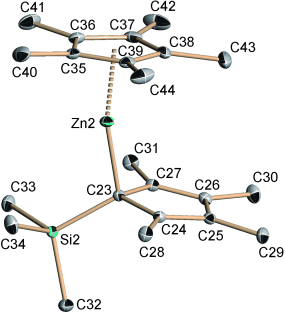Rigid or flexible? Zincocenes [ZnCp′2] may adopt different structures depending upon the nature of the cyclopentadienyl substituents. A zincocene with a rigid η5/η1(σ) solution and solid-state structure has been prepared and structurally characterised as containing η5-C5Me5 and η1-C5Me4SiMe3 rings (see figure).

Abstract
New zincocenes [ZnCp′2] (2–5) with substituted cyclopentadienyl ligands C5Me4H, C5Me4tBu, C5Me4SiMe2tBu and C5Me4SiMe3, respectively, have been prepared by the reaction of ZnCl2 with the appropriate Cp′-transfer reagent. For a comparative structural study, the known [Zn(C5H4SiMe3)2] (1), has also been investigated, along with the mixed-ring zincocenes [Zn(C5Me5)(C5Me4SiMe3)] (6) and [Zn(C5Me5)(C5H4SiMe3)] (7), the last two obtained by conproportionation of [Zn(C5Me5)2] with 5 or 1, as appropriate. All new compounds were characterised by NMR spectroscopy, and by X-ray methods, with the exception of 7, which yields a side-product (C) upon attempted crystallisation. Compounds 5 and 6 were also investigated by 13C CPMAS NMR spectroscopy. Zincocenes 1 and 2 have infinite chain structures with bridging Cp′ ligands, while 3 and 4 exhibit slipped-sandwich geometries. Compounds 5 and 6 have rigid, η5/η1(σ) structures, in which the monohapto C5Me4SiMe3 ligand is bound to zinc through the silyl-bearing carbon atom, forming a ZnC bond of comparable strength to the ZnMe bond in ZnMe2. Zincocene 5 has dynamic behaviour in solution, but a rigid η5/η1(σ) structure in the solid state, as revealed by 13C CPMAS NMR studies, whereas for 6 the different nature of the Cp′ ligands and of the ring substituents of the η1-Cp′ group (Me and SiMe3) have permitted observation for the first time of the rigid η5/η1 solution structure. Iminoacyl compounds of composition [Zn(η5-C5Me4R)(η1-C(NXyl)C5Me4R)] resulting from the reactions of some of the above zincocenes and CNXyl (Xyl=2,6-dimethylphenylisocyanide) have also been obtained and characterised.


